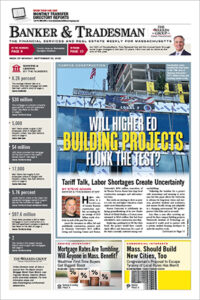
Newly built homes in Waterville Valley. New Hampshire homebuilders say that while the housing market seems capable of absorbing some home price increases due to tariffs, the latest episode of America’s trade wars is keeping their anxiety levels high. iStock photo
The U.S. and China may have reached an agreement to temporarily reduce the punishing tariffs each country has imposed on the other in recent weeks.
But if a similar delay in tariffs with Canada and Mexico is any indication, postponing tariffs won’t relieve the trade-war anxieties, confusion and pressures that have already contributed to price and supply turmoil in various business sectors, including New Hampshire’s homebuilding industry.
Those involved in homebuilding in the Granite State report construction material prices have increased in recent weeks – even after many of the tariff moves announced on April 2, dubbed “Liberation Day” by the Trump administration, were temporarily suspended for 90 days.
“It’s not the actual tariffs that are the problem, it’s all the uncertainties and unknowns,” said Tedd Benson, founder of Bensonwood and Unity Homes, a Walpole, New Hampshire-based builder of high-performance sustainable homes. “It’s the uncertainties that are driving price increases and other problems. The uncertainties are almost as impactful as actual tariffs.”
And those uncertainties and unknowns are contributing to prices spikes in lumber, steel, copper wiring and other construction materials and equipment, industry leaders say.
Vendors Raising Prices, Regardless
Eric Jackson, director of acquisitions and development at the Stabile Companies in Nashua, said vendors are raising prices for a number of reasons, including in response to actual tariffs that haven’t yet been suspended by the Trump administration.
But he added some vendors appear to be raising prices as a way of hedging against potential tariffs that may be reimposed or future tariffs that haven’t been proposed yet.
“Some of it is tariff anticipation,” said Jackson. “A combination of things is driving price volatility.”
Earlier this year, the National Association of Home Builders warned that tariffs could add $10,900 to the cost of a new home if they stayed in place – and Jackson said that events appear to be confirming that estimate.
“There’s no question prices are going up – and I have no doubt tariffs are factoring into it,” he said.
Preston Hunter, vice president of Eckman Construction in Bedford, said building prices began to jump even before “Liberation Day” in early April. Merely the fear of tariffs prompted price spikes, he noted.
The U.S. Construction Producer Index, for example, showed a 4.1 percent increase in steel mill prices in March, before April 2, Hunter noted.
Copper wire prices were up 5.5 percent in March, while softwood lumber prices jumped by 4.7 percent, he added.
“A lot of subcontractors are throwing up their hands and saying, ‘I know what the prices will be over the next seven days, but I can’t tell you what the prices will be in six months,’” said Hunter, whose firm builds multifamily housing and commercial facilities. “The quotes coming in are for only short periods of time.”
Hunter said the current environment reminds him of the COVID era, when uncertainty led to wild construction price swings, usually price swings upward.
He added he’s concerned all the turmoil and confusion could lead to some “contractual legal problems” within the industry, with subcontractors, contractors and clients disputing price agreements.
NH’s Lumber Industry Hit, Too
In New Hampshire, most of the tariff attention has been focused on the rising prices of import items, especially imports from China where many appliances, equipment and other trade products used in home construction are manufactured.
But the tariff controversy is also hitting New Hampshire exports, particularly the state’s timber and lumber industry.
Jason Stock, executive director of the New Hampshire Timberland Owners Association, said many local foresters, loggers, sawmills and paper mills are getting hit hard by ongoing tariff disputes.
Some mills are even temporarily shutting down, or reducing operations, because they’re unable to sell products to overseas customers.
“They’re just waiting it out,” Stock said. “They no longer have a market to sell to. We’re seeing a lot of pain. It’s been a real mess for us.”
Producers of hardwood products, which are used in flooring and furniture, are getting especially hammered by Chinese tariffs.
Stock noted that he knows of one local hardwood producer who recently shipped $600,000 in lumber to China – only to have the Chinese buyer balk at purchasing the wood at higher tariff-inflated costs.
The net result: the lumber is now sitting in trade limbo on a Shanghai dock, Stock said.
Amid all the tariff-related controversy, yet another building industry issue is starting to emerge: labor problems.
Specifically, immigrant workers who are suddenly leaving jobs amid the Trump administration’s aggressive crack down on illegal immigrants in the U.S.
“I’m hearing it from subcontractors in the trades,” said Jackson. “I’m hearing stories of folks losing workers.”
And any labor losses will only exacerbate challenges from tariffs and other, more familiar issues facing the homebuilding industry.
Can Market Bear Higher Prices?
A big question in the industry: At what point might today’s rising costs of construction – and thus rising prices of new housing – impact demand for newly built homes?
Jackson said that, for now, the demand for homes is so strong in New Hampshire that he doesn’t see higher prices cutting into sales in the immediate future.
“The demand for homes has been astonishing,” said Jackson.
Still, he expressed concern that, eventually, home prices could reach a breaking point for many would-be buyers.
Benson, founder of Bensonwood and Unity Homes, agreed that the tariffs are just the latest challenge to face the homebuilding industry in general.
“It’s getting scary out there,” he said. Tariffs “are making our clients or potential clients nervous. It’s bringing the industry to a sort of wait-and-see mode. Our company is now in a kind of holding pattern.”






